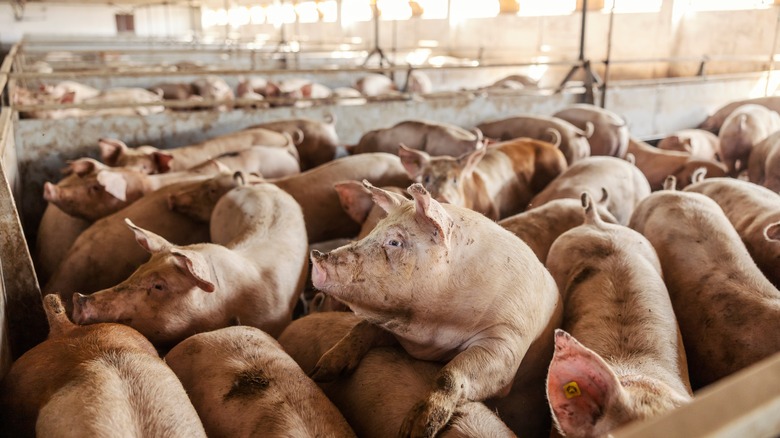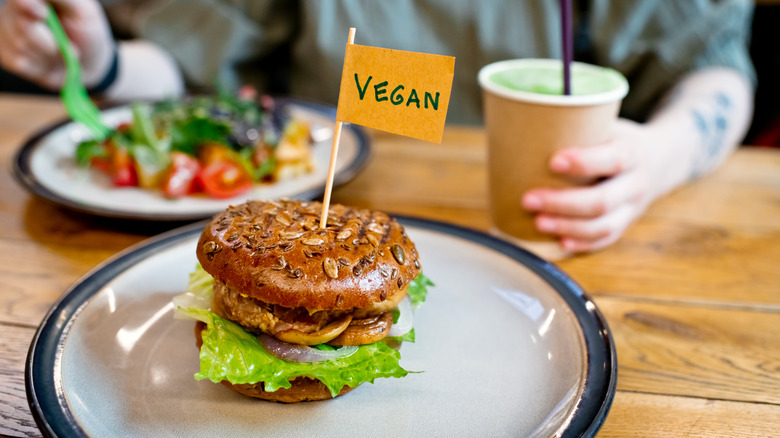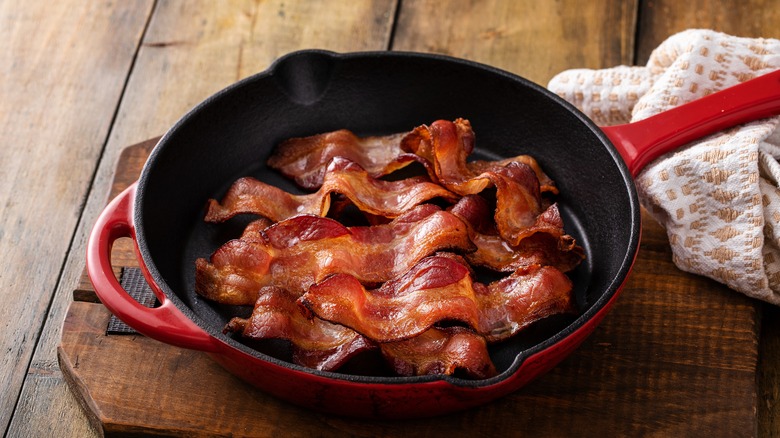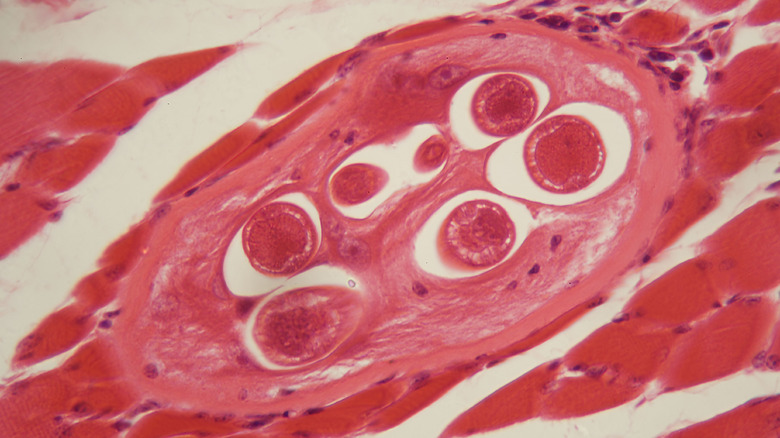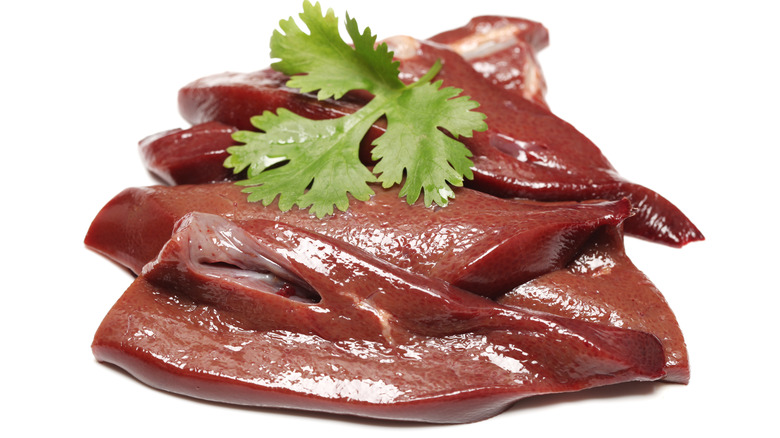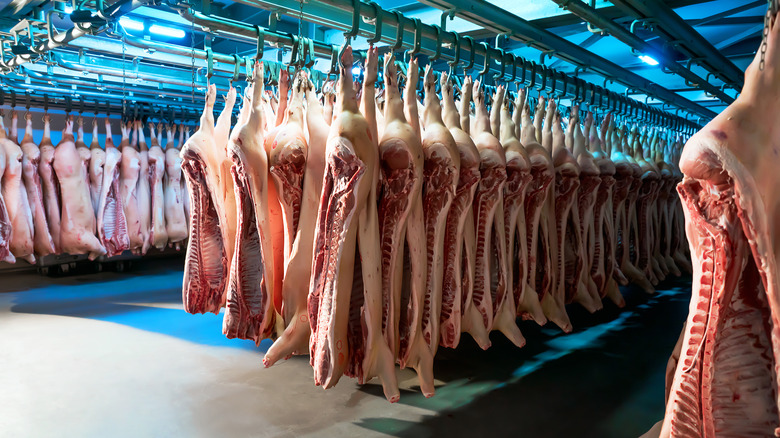Billions Of People Around The World Don't Eat Pork. This Is Why
The pork industry has faced a squeeze of late, with California leading the way with Proposition 12. Prop 12 requires pork producers to provide more humane living conditions for sows. These changes come in at nearly $4,000 per pig in some places, per CNBC, and are intended to make the birthing process less traumatizing for pigs. Prop 12 represents just one that the pork industry has faced in recent years, which in part comes from people's desire to eat something other than pork, or at least to ensure that pigs' living conditions in pig farms rise to a more acceptable level. While those in the farm industry have been suggesting that a farm bill is necessary to help struggling pig farmers, those who shy away from eating pork see such steps as a victory.
The fact is that billions of people around the world don't eat pork. Their reasons vary, though challenges like Prop 12 offer a look at some of the reasons why pork isn't on the menu in so many homes. Some who avoid pork cite religious beliefs. Others avoid eating pork because of its environmental impact. Still others, upset by the treatment of both pigs and humans in pork processing plants, have replaced their pork chops and bacon with pasta and broccoli. And one can't forget how filthy pigs are inside and out. From slaughterhouse blues to kosher meals, here's a look at why so many people have opted out of eating pork.
It's forbidden in the Torah
For those who exist outside the world of Judaism, the word "kosher" most often comes up in the form of kosher salt. And while kosher is certainly a label, there's a whole set of rules that exist behind that label, including the types of meat kosher eaters can consume. What does stand at the forefront is the types of meat that kosher eaters will and won't eat, pork being chief among them.
Pork, along with shellfish, is considered an unclean animal. As such, the 22% of American Jews (and countless others around the world) who follow kosher diets don't eat pork. To be kosher, an animal must chew its cud and have a cloven hoof. While pigs have a cloven hoof, they don't chew their cud. Cows and sheep fit both criteria, which is why those animals end up on dinner plates in kosher households. Those animals are called ruminants.
This dietary rule goes back to ancient days, though modern science has brought to light the general uncleanliness of a pig's system. Scientific research shows the presence of parasites in the pig's system, for example, demonstrating how knowledgeable ancient kosher eaters were. Their dietary laws reduced the possibility of infection by quite a bit, and for many, the wisdom of kosher still rules the table today.
Muslims avoid pork, too
In the Quran, certain foods, called "haram," are considered impure, with pork being one of them. Although the dietary laws in the Quran go back as far as Jewish food laws do, modern science has since supported the rationale behind the halal designation that labels meats to eat for Muslims around the world.
Chock full of different toxins and bacteria and even certain worms, like the trichinae worm, it isn't an exaggeration to say that Muslims look at pigs as walking trash bins. The fact that pigs even eat their own waste doesn't help matters any. Because of this, Muslims adhere to the idea of "You are what you eat," so eating pork means that pork eaters have the same character and constitution as the pig they eat. The only exception to this rule is in situations of potential starvation due to a lack of available food options.
Seventh Day Adventists (SDA) are on board with no pork, too
Seventh-Day Adventists count among those who don't eat pork for religious reasons. They adhere to Jewish food laws in that they don't eat unclean meats, like pork. However, they take it further by not eating meat of any kind usually.
Because of these dietary practices, Adventists in Loma Linda, California, have placed themselves solidly in the Blue Zone category. Blue Zones are the places on Earth where more people per capita live to be 100 years old or more. Five Blue Zones exist on the planet, but the only one in the U.S. is in Loma Linda, largely due to the number of Adventists who reside there and who eat a pork-free, vegetarian diet.
However, vegetarianism and veganism aren't a new thing for Adventists. Since nearly the inception of the church over 150 years ago, Adventists not only ate more closely to Jewish food law but also began adopting a vegetarian diet to bring them closer to the diet that Adam and Eve would have eaten in Eden, which, you could argue, was the world's first pork-free Blue Zone for the first people on Earth.
Most Indians often forego pork
Until the 16th century, Indians ate pork. That changed when the country came under the rule of the Muslim Mughal Empire. Although many of India's religions don't forbid pork consumption, the influence of the country's Muslim conquerors continues to guide people's food choices today.
The PEW Research Center has indicated that 81% of Indians submit to some restrictions in their diets where meat is concerned. But how this plays out varies, meaning that some of them won't eat certain kinds of meat, including pork. Others restrict the days that they will eat meat, and most Indians claim to be vegetarian. These restrictions vary because of the variety of different religions, which include Muslims, Christians, Hindus, and Jains, all of which have their own sets of dietary laws.
While it's true that there are religious reasons for some Indians to refrain from pork consumption, there is also a general feeling amongst Indians that pigs are walking diseases just waiting to happen. This belief arises out of what people know about the differences between ruminant animals, like cows, and scavengers, like pigs. Animals who are ruminants take 24 hours to digest their food in a series of four stomachs. Pigs only have one stomach, which takes about four hours to digest all food. This walking-garbage-scow image of pigs became such an issue during the British rule of India that it was often nearly impossible to find cooks who would make morning ham or bacon for the Brits.
Some people prefer not to eat meat at all
While some religious groups, like Seventh-Day Adventists, turn to a vegetarian or vegan lifestyle largely for health reasons, other people avoid eating meat, including pork, because they don't want to eat meat at all. Some of these non-pork eaters, who fall into the "vegan" and "cruelty-free" categories, believe that animals have feelings, too. The non-consumption of animal products of any kind plays a central role in the decisions they make about their food choice. Not only do they not eat meat, but they also don't buy products, like leather, and in the most extreme cases, they won't buy products where questionable work practices or conditions exist, either.
Their caution concerning the prevention of cruelty to pigs is especially poignant. Per PETA, 170,000 pigs die in painful and cruel ways in transport to slaughterhouses each year, and another half a million of them face searingly painful injuries as a result of accidents on the road along the way to the bacon bridge. They're given no painkillers after their injuries and are often left to die where they are when transport trucks wreck. For the non-pork eaters in this group, not succumbing to the temptation of bacon in the morning means not contributing to this all-too-common cruelty.
Cured or processed pork has been linked to cancer
If you've spent any time on social media in recent years, then you know that bacon has become a bit of a celebrity. The cured meat engenders the kind of amore often only reserved for lovers. Part of its attraction comes from the nitrates and other chemicals that give bacon its crunchy pink deliciousness. Chalk this up to the salts that are in nitrates.
But that's not all that nitrates bring to the table. Nitrates have been shown to cause cancer in mice. According to a study by Queen's University Belfast, mice that were given a diet of meat containing nitrates developed 75% more tumors in their intestines than mice that ate a different diet. These types of findings in scientific studies have prompted scientists to call cured meats carcinogens and have led entire countries to ban nitrates altogether. Granted, people are not mice, but even eating as few as four strips of bacon a day can potentially increase the prevalence of cancer in some, which is why some cautious foodies avoid pork, or at least, cured pork.
Pigs and parasites go together
Most people, having their druthers, would not eat a trichinella worm on purpose. That's because, under the right circumstances, these larvae worms burrow into the intestines and eventually find their way to the muscles of the body and wreak havoc. Headaches, pink eye, fever, bodily weakness, and more can result, making the carrier of the worm very sick.
So what are the right circumstances for this burrowing beast to get inside your intestines and muscles? Eat some infected pork, and you're ready for an epic trichinosis infection. But the trichinella worm isn't the only parasite that inhabits the interior of a pig. Other parasites and viruses live inside the body of pigs, which include tapeworms, the menangle virus, and more. Humans exposed to these micro-sized baddies can contract diseases from infected pigs.
The side effects of consuming these harmful bacteria, worms, and viruses bring on problems with digestion, rheumatism, multiple sclerosis, and gall bladder issues. Needless to say, these microscopic dark actors dissuade many people from eating pork because these viruses and bacteria can be passed on from pig to human just from eating the meat of infected pigs. In some cases, cooking the food thoroughly doesn't even off the little beasts, so avoiding them altogether represents the wisest policy for many who choose not to eat pork.
Pork can cause inflammation in the body
Omega-6 fatty acids cause the body to develop inflammation. Pork just happens to contain a large amount of omega-6, at least compared to the amount of omega-3s that it has. This makes pork one of the most inflammatory foods around. And while it's known that cured pork ups the inflammation factor, uncured pork may also make those who suffer from inflammation think twice about indulging in pork chops and other pork cuts. That's because red meat, including pork, is known for its inflammation-causing effects.
But what does that mean in practical terms? Inflammation can lead to conditions and diseases like arthritis, heart disease, and even weight gain. People who suffer from these maladies will avoid foods that fire up inflammation. For many, this means skipping the breakfast bacon or the Easter ham for healthier fare that's not quite so hard on the heart, joints, and more. Better options for those pork-avoiding foodies include tofu, fish, and beans, which offer the protein power that people look for from pork but in a more body-friendly, anti-inflammatory kind of way.
Hepatitis E thrives in pork liver
Zoonotic diseases are the kind of thing that you'd expect to hear about watching some sci-fi movie like "Dune" where people catch some crazy disease because they moved from one planet to another. But in reality, this kind of disease actually represents a passing of illness from wild or farm animals to humans. For eaters of pork, particularly pork liver, the disease in question is hepatitis E.
Despite being a common thing on most pig farms, it's often unknown which of the pigs in question carry the disease until it's too late. The big tip-off for the disease often comes from the development of the symptoms of hep E. If you've eaten pork recently and have suddenly experienced symptoms like jaundice, low-grade fever, vomiting, fatigue, and abdominal pain, you may want to head off to the doctor to check to see if you've contracted hepatitis E.
For most people, hep E is a short-term illness that affects the liver. However, the condition can become chronic in people whose immune systems are weak in some way. This includes those who have had organ transplants, who are pregnant, or who are affected by the HIV/AIDS virus.
Although this disease can be prevented by cooking pork well, some people opt to skip pork meat altogether, due to the potentially serious nature of the disease. It's also worth noting that it isn't only pigs that carry the disease. You can get it from the meat of wild animals like deer, too.
Drug-resistant bacteria can live in pigs
Staphylococcus aureus makes its way from person to person via contact with the germ on the hands, or sometimes, from nose to hand and then from person to person via the hands. However, a strain of the bacteria lives on pigs. As it turns out, swine are just as good at passing on the bacteria as your hands are.
Unfortunately, some of the buggies that go from pig to person qualify as superbugs, with their superpowers being a particular resistance to antibiotics, regardless of whether they're on a pig or a person. One such strain of the bug is CC398. It has been hitchhiking its way around Europe for decades, according to Cambridge University. But being the tricksy thing that it is, it has managed to jump across the pond to the U.S. and beyond, making it kind of slippery in only the way that a germ can be. The superbug has set off the alarms in the scientific and medical communities because of how easily the bug jumps from animal to human.
But that's not the only bug that's bothering the little piggy next door. Clostridioides difficile, a bacteria that causes digestive upset and inflammation, is also making the rounds. These challenges represent a gigantic issue for medical personnel around the world. Hundreds of thousands of people die each year after succumbing to the bugs.
Pork production plants aren't great for pigs or workers
Socially-conscious food nerds know that life on a pig farm is about as far from "Charlotte's Web" as you can get. As such, they avoid eating pork because pig farms are no piggy picnic, starting pretty much from a pig's birth. In the natural progression of things, weaning a baby pig from its mother takes up to three months. In a factory, it takes three or four weeks, at which time, the piglets get put into a cage, where they endure a slit of the ear and a slash of the tail, all to make things more expedient for identification and to prevent tail biting in such close quarters.
Life isn't much better for their mothers. About six million pigs are earmarked for breeding each year. The newest factory machinery at the turn of the century in the Industrial Revolution had nothing on these pigs. They produce piglet after piglet, only getting a reprieve, of sorts, for the four months that they are pregnant and nursing before the process starts over again.
But it isn't only the pigs who suffer. Life for workers at a pig farm is volatile, to say the least. The noise is jarring. Respiratory illnesses are rampant due to the dust and other particles flying around in the air. Salmonella likes to hang out at pig farms, too. It probably comes as no surprise, then, that depression, family problems, and sometimes even suicide can become problems among pig farmers.
It's terrible for the environment
When you think about climate change, pig farming may not be the first thing that comes to mind, but maybe it should. As Biological Diversity points out, the average annual environmental cost of bacon consumption per person comes in at about 1,050 pounds of carbon dioxide equivalents. You'd be forgiven for thinking that poundage must be an awful lot of bacon. It's not. It's less than 52 slices per person per year. At this juncture, you might also be asking how such a thing could go on. The long and short of it is the pork industry has incredible power in the marketplace to the tune of one trillion dollars worldwide. Ninety-two percent of all pork production in the U.S. comes from just 30 pork processing plants, according to Food Print.
But all is not lost. There are some reports that the growing trend toward veganism has left a serious impact on the pork industry. Per Live Kindly, nearly 50% of young adults eschew eating meat including pork due to its environmental impacts. Interest in veganism has increased by 600% in recent years, which cost the meat industry $20 billion in 2020. While the numbers on both sides have evened out a bit since then, one thing is certain: People have begun voting with their wallets, and the pork industry is getting voted off the table time and time again.
